Please find below the
Finalist Evaluation
Judges'' ratings
| • | Novelty: | |
| • | Feasibility: | |
| • | Impact: | |
| • | Presentation: |
Judges'' comments
Congratulations! Your proposal, Networking Rwanda's Air Pollution Problem with Low-Cost Air Quality Sensors, in the Transportation contest, has been selected to advance to the Finalists round.
Be proud of your accomplishment – more than 350 proposals were submitted and only a very small number have been advanced through these two rounds of judging.
As a Finalist, your proposal is eligible for the contest’s Judges Choice award, as well as the contest’s Popular Choice award, which is determined by public voting.
If you haven’t already, you will soon receive an email from the Climate CoLab staff with details about the voting period. If you don’t receive that email within the next day, or have other questions, please contact the Climate CoLab staff at admin@climatecolab.org
All winners will be announced the week after the voting period ends, on September 12, 2015 at midnight Eastern Time.
Both Judges Choice and Popular Choice will receive a special invitation to attend selected sessions at MIT’s SOLVE conference and present their proposals before key constituents in a workshop the next day, where a $10,000 Grand Prize will be awarded. A few select Climate CoLab winners will join distinguished SOLVE attendees in a highly collaborative problem-solving session. Some contests have additional prizes given by the contest sponsor.
Thank you for your work on this very important issue. We’re proud of your proposal, and we hope that you are too. Again, congratulations!
2015 Climate CoLab Judges
Additional Comments:
-This is a nice, practical proposal of manageable scale that could lead to an increased awareness of local air pollution and potentially climate change in a developing economy. My main concern is the only indirect relation to climate.
-I like this proposal. It has relatively low cost, but very much achievable, and could have significant long term impact, given the expected growth of African emissions. Gaining an understanding of emissions, including CO2, in Kigali would not only inform decision makers, but could be used to inform the general population about air quality as well as climate impacts. The latter is of particular importance because climate impacts are expected to be higher for many developing regions because of the relative impact of increased temperatures.
I appreciate the effort to tie the proposal back to climate impacts. Thank you. it may help to have numbers on potential CO2 reductions as well as the stated numbers on black carbon and particulates. Also, the author states that there will be periodic visits to the sites to characterize traffic etc. What would these entail? Are periodic visits enough? This would also help to tie it back to the Transportation theme.
I also like the discussion about the limitations of the sensors and suggested efforts to characterize their response to temperature etc.
Semi-Finalist Evaluation
Judges'' ratings
| • | Novelty: | |
| • | Feasibility: | |
| • | Impact: | |
| • | Presentation: |
Judges'' comments
SUBJECT: Your proposal has been selected as a Semi-Finalist!
Congratulations!
Your proposal, Networking Rwanda's Air Pollution Problem with Low-Cost Air Quality Sensors in the Transportation contest, has been selected to advance to the Semi-Finalists round.
You will be able to revise your proposal and add new collaborators if you wish, from July 1st until July 14, 2015 at 23:59pm Eastern Time.
Judges' feedback are posted under the "Evaluation" tab of your proposal. Please incorporate this feedback in your revisions, or your proposal may not be advanced to the Finalists round. We ask you to also summarize the changes that you made in the comment section of the Evaluation tab.
At the revision deadline listed below, your proposal will be locked and considered in final form. The Judges will undergo another round of evaluation to ensure that Semi-Finalist proposals have addressed the feedback given, and select which proposals will continue to the Finalists round. Finalists are eligible for the contest’s Judges Choice award, as well as for public voting to select the contest’s Popular Choice award.
Thank you for your great work and again, congratulations!
2015 Climate CoLab Judges
This is a well-presented proposal.
It is achievable and has real near term benefit. The drawback is that the connection to climate change is weaker, as the author points out. However, I do agree that this project would increase the probability of emissions reductions in Rwanda, and ultimately through all of the developing world. So it has potential for significant impact. Source apportionment sounds particularly interesting/useful. What are the limitations of the low cost equipment, and how robust are they? Some more details on the type of policies that could benefit from this work would also be helpful.
We would like to see a bit more solid thinking on how policies could be influenced based on the monitoring systems and to what direction.
This is a solid proposal for an air quality monitoring program in a developing world city with acute air quality problems.
 Langley Dewitt Jul 13, 2015 06:57 | Proposal creator
Dear Judges,
Thank you very much for your helpful feedback on this proposal! I have made several additions to the proposal to answer your concerns.
In regards to the air quality monitors, they are robust and can be left in their location for months to a year at a time. They will be packaged in weatherproof 3D printed plastic. Current results suggest that once/year calibration is enough (results from the MIT CLAIRITY network). The major drawback to these devices is that their accuracy is not at regulatory-levels yet, and requires an understanding of the response of electrical chemical sensors to things like RH and temperature. This information has been added to Section III of the Project Description.
In terms of policy, I have added paragraphs on potential policy in two locations in the proposal:
Section IV in the Project Description, I have added more description of potential policy (located at the end of this paragraph):
Major policy concerns include the prevalence of older diesel vehicles and buses on the road, the use of inefficient cookstoves, agricultural burning and emissions (e.g., methane from rice fields), poor traffic flow within the city, and the large concentration of mototaxis within the city. The contribution of cookstoves vs vehicular emissions to air quality is controversial, and using the CO to NOx (NO+NO2) ratios, measured by the sensors, will theoretically allow source apportionment of diesel versus burning emissions (as vehicles and cookfires emit different ratios of CO/NOx). These data will help policy makers focus on the heaviest emitters first. Locating the sensor next to major roadways will allow pollution concentrations over the day to be observed and the 10 second time resolution of the sensors will allow individual emission plumes from passing vehicles to be captured, demonstrating the effectiveness of enforcing emissions testing. This will also help the government target areas for improved traffic flow (e.g., traffic light sensors, wider roads). Other examples of policy that could arise from these measurements are low and no burn days, purchase of more efficient buses and increased bus coverage, lower building height to reduce urban-canyon effects, and an enforcement of a no-idling policy in bus parks. Rwanda has recently adopted a low-sulfur fuel policy, but requiring higher purity of fuel for vehicular use could also reduce emissions.
And in the timeline, 5-15 years, this paragraph has been added:
•Development of more policy to guide Rwanda’s growth. Future policy, depending on initial experimental results, to regulate emissions could include 1) stricter emission regulations 2) regulations on the type of vehicle allowed to be imported into Rwanda 3) purchase of newer, more-efficient and larger capacity buses and increased bus coverage 4) introduction of measures to control traffic flow (e.g., sensor-based traffic lights, wider streets) 5) regulations on cookstoves for purchase (must be above a certain level of efficiency) 6) bike lanes on major roads and mapped bike routes around the city 7) a push for the construction of energy-efficient buildings and use of alternative energy (as Rwanda is sunny most of the year, and at high altitude, solar energy would be particularly attractive), among others. If Rwanda transitions quickly to emission levels such as those in North America, its development will avoid an initial heavy emission phase.
|
 Langley Dewitt Jul 14, 2015 08:28 | Proposal creator
I have also tried to emphasize the idea that we will be trying to make these low-cost air quality sensors, currently not accurate enough for regulatory purposes, accurate enough for more widespread use (through the understanding of their response to different atmospheric conditions, such as RH and Temperature). This will drastically increase access to air quality and emission measurements in the developing world. (in the timeline 5-15 years section, have added "Widespread use of accurate low-cost monitoring equipment and building the capacity to use this equipment will be transformative in emission regulation and monitoring in developing countries".
Other examples of policy now added are increased carpooling with government tax incentives for this. In the future, mobile units (already being developed) can be placed on moto taxis with a gps to further break down the areas where gridlock/idling is causing heavier emissions and target those for increased traffic flow initiatives like timed lights, etc (at the end of the description section I, added the sentence **As technology develops, mobile units can be placed on motos equipped with gps to track pollution around the city and capture traffic plumes in motion. And Mobile units on motos will help the government target areas for improved traffic flow (e.g., traffic light sensors, wider roads) (section IV Deliver Data to Policy Makers). A discussion on the purchase of cleaner buses has been moved from section II in the description section (Monitoring sites) to Section IV (Deliver Data) to emphasize that this would be a desirable policy outcome. Also the desirable outcome of the government reducing taxation on investors in public transport (a reason for few bus companies in Kigali) is discussed in this paragraph: " Locating the sensor next to major roadways will allow pollution concentrations over the day to be observed and the 10 second time resolution of the sensors will allow individual emission plumes from passing vehicles to be captured. For example, public transport in Kigali is via older diesel minivans, known to be heavy emitters of pollutants with low fuel efficiency. Recently, newer buses have been purchased. By comparing pollution plumes from newer public buses versus older minivans, data can be collected to demonstrate the efficacy of introducing newer buses into rotation to reduce emissions in Kigali. This could be an effective way to demonstrate the need for cleaner buses, and encourage the government to reduce the tax barrier to investment in transport. "
|
